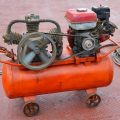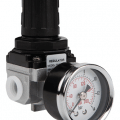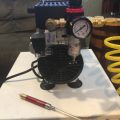This page is dedicated to providing you with a way of calculating the CFM of your air compressor’s output and pump. If your compressor is stated to generate 6 CFM of compressed air at 90 PSI, you may wonder how much it can generate at 60 PSI? Various techniques on how to calculate CFM at various pressure levels will be presented.
Table of Contents
- The Relationship Between CFM and PSI
- Air Tank Outlet and Pump Relationship Between CFM & PSI
- How to Calculate CFM of an Air Compressor
- Using a Flow Meter to Calculate CFM
- FAQS (Frequently Asked Questions)
The Relationship Between CFM and PSI
Before we get into the calculations, let’s answer what is the relationship between CFM and PSI? CFM is the flow rate or the compressor’s ability to continue performing tasks over a certain amount of time. It basically expresses the amount of flow that is needed and depends on the length of time required to complete tasks. With insufficient flow, the compressors will require breaks to rebuild pressure in the compressor’s air tank.
PSI (pounds per square inch) is the pressure of the air. PSI expresses the compressor’s ability to perform a specified amount of work at almost any given time. The compressor must be able to provide the right amount of pressure needed to complete the process.
In terms of compressed air, pressure delivers the force, and horsepower delivers the flow. Too little pressure means you will not be able to complete tasks, while too much pressure can lead to damaged equipment and unexpected malfunctions.
Between CFM and PSI, the two measurements essentially define whether a compressor can meet the demand of your equipment. Each piece of equipment or tool will have a CFM requirement in order to operate effectively.
The relationship between CFM and PSI is not so simple due to the fact that there are temperature fluctuations and pressure changes inside the compressor tank with airflow. Often numerous Engineers try to chip on this relationship but forget which part of the system is in question, the outlet or pump.
The air compressor pump is designed to produce air at a certain flow rate and a certain pressure efficiently. If the pressure is changed, or the CFM that the air compressor pump needs to operate at sufficiently, you will have efficiency losses. This, therefore, indicates the complexity of the relationship between CFM and PSI.
Air Tank Outlet and Pump Relationship Between CFM & PSI
Let’s focus on the air tank first. If the air compressor tank has a regulator attached to is set to 90 PSI while the air tank itself is always kept within 90-120 PSI. We’ll label the continuous CFM out of the regulator as “x”.
If we were to adjust the pressure at the regulator to 30 PSI and the air in the tank is still kept between 90-120 PSI then the continuous CFM out of the regulator is equal to 3*”x”, approximately!
Note: this is an approximation as temperature fluctuations are a key factor, along with the air containing moisture and potential contaminants.
This scenario relies on the fact that the air compressor pump has an average CFM above “x” when replenishing the air into the tank at 90-120 PSI. The relationship between CFM & PSI depends highly on where you’re measuring it.
At the air tank outlet, the relationship between CFM and PSI is inversely proportional and so:
- If PSI doubles, CFM halves
- If CFM doubles, PSI halves
- If PSI halves, CFM doubles
- If CFM halves, PSI doubles
When it comes to the CFM and PSI relationship at the compressor pump, the relationship won’t be near linear. This is because each pump will have its mechanical configuration to operate at specific ranges of PSI and CFM.
Therefore, it is the air compressor tank outlet CFM and PSI relationship that really matters to users. The CFM and PSI at the outlet of the air compressor tank/regulator have no relationship with the CFM and PSI relationship in the air compressor pump if the CFM of the compressor is below its stated amount of 90 PSI (like in the example provided).
The reason behind this is simple, the air compressor tank decouples the CFM of the air compressor pump from the CFM flowing out of the air compressor regulator.
You must ensure that any write-ups or calculations you’re using for CFM, or the relationship between CFM and PSI, states wherein the system both are being measured. Are they talking about the CFM and PSI relationship in the tank/regulator outlet or in the pump? The relationship between these two parts of the pneumatic system is completely different.
It’s easy to remember that the compressors pump CFM is specified in the user manual or product specification. If you cannot find this, contact the manufacturer directly to find out. Also, remember that if you’re using the compressed air, regulated to 30 PSI, this does not mean the compressor’s pump is operating at 30 PSI. The pump will operate at its factory set cut-in and cut-out pressures around the 90 PSI mark.
How to Calculate CFM of an Air Compressor
A lot of people have various types of methods to calculate CFM on an air compressor. I will present to you two of the most popular methods – please note that they are very similar methods, except from the last part of both, they follow the same process.
Note: I can not indicate how trustworthy or accurate these methods are, I am just presenting you with two of the most popular methods found across internet research.
Method 1
The air compressor CFM PSI calculator formula is the following:
CFM = tank volume in cubic feet x standard pressure (ATM) during cycle x cranks per minute.
For example, a 2 HP compressor with a 10-gallon tank rated 5.77 CFM at 90 PSI, like this Hulk silent series EMAX compressor readily available on Amazon. Let’s work backward with the formula and see where we get!
First of all, let’s convert the capacity of the tank to Cubic Feet:
Where 1 Cubic Ft = 7.48 gallons. Therefore, 10/7.48 = ~1.34 Cubic Ft
The next step would be to start the compressor and measure the time of the load and unload cycle on the tank’s gauge. Use a stopwatch and time how long it takes for the compressor to stop running from when it starts to run. Watch the tank gauge during this time and record the PSI, both when the compressor starts and stops running.
If you are starting up a compressor that has been turned off, you should let the tank fill completely once before starting your timing and recording the results.
If the compressors loads at say 80 PSI and unloads at 120 PSI, there is a 40 PSI differential pressure. Next you must convert this differential pressure into standard pressure (ATM):
Where 1 ATM = 14.7 PSI. Therefore, 40/14.7 = 2.72 PSI
The tank pump-up time is estimated to be around 1 minute 30 seconds (1.5 minutes)
Now you have the three primary factors:
- Tank volume = 1.34 Cubic Ft
- Standard pressure during cycle (ATM) = 2.72 PSI
- Cranks per minute = 3 minutes
So the CFM can be calculated using the formula presented at the start:
1.34 x 2.72 x 1.5 = 5.47 CFM which is fairly close to the manufacturers rating of 5.77 CFM. The 0.3 difference is likely to mostly be down to the rounding, or the pump-up estimation time.
Method 2
The way to measure true power is to measure the time it takes to pump the reservoir tank of known volume from a known starting pressure to a known ending pressure. Then you can figure out the true CFM from the difference in the starting and finishing pressures, multiplied by the volume of the tank, and divided by the time it took to reach cut-off pressure from the cut-in pressure. These true performance measurements are impossible to fake.
To begin this method, you must determine the volume of your air compressor tank in gallons, which should be clearly marked on the tank itself. Then, divide the tank volume by 7.48 (no. of gallons to cubic feet). This resulting number is then measured in cubic feet. The air can now be released from the compressor.
Begin refilling the compressor with air and record the amount of time it takes to refill the tank while paying close attention to the compressor’s tank gauge. You will need to record the PSI ratings from when the compressor kicks in and kicks out (cut-in and cut-out pressures).
Subtract the cut-in pressure from the cut-out pressure. E.g let’s say the compressor kicks in at 70 PSI and kicks out at 100 PSI then the difference would be 30 PSI. Divide this difference by 14.7 (ATM) and this will give you the amount of pressure added during the tanks filling cycles in terms of atmospheric pressure.
Take the volume of the tank expressed in cubic feet and multiply it by the amount of pressure difference just recorded during the tanks refilling process. This answer is the number of cubic feet that your compressor pumps in the time it took for your compressor to fill the tank.
Convert this number to minutes by dividing the number of seconds it took to pump this amount and then multiply that result by 60 and you have the CFM of your air compressor.
I have picked out this article online which has a section towards the bottom with multiple readers’ comments and suggestions on how to calculate air compressor CFM. Another alternative is using an online calculator to predict the pump uptime and the CFM which is available here.
Using a Flow Meter to Calculate CFM
The easiest way to calculate the CFM of an air compressor is to use an airflow meter. This will allow you to measure the amount of flow and the pressure that is coming out of a fitting. The flow meter can be installed on individual pieces of equipment or even complete systems to provide an instant reading of actual usage.
For more accurate readings, the flow meter should be near the receiver tank to even out peaks and valleys in the data. There are numerous types of flow meters that can be used for point-of-use measuring, and in-line measuring.
My advice, for the pressure of the airflow to be tested at the compressor discharge, I would be inclined to install the regulator at the air tool end, ensuring the pressure of the flow at that point. Between the regulator and point of use, install an in-line flow meter.
There are many good makes and manufacturers of flow meters readily available online. Conduct an efficient Google search and you’ll easily come across one that suits your needs!
FAQS (Frequently Asked Questions)
To calculate CFM of an air compressor, you must convert the volume in gallons to cubic feet using 7.48 per 1 cubic feet. Then take note of the cut-in and cut-off pressures and divide the difference between them by 14.7 (atmospheric pressure). Multiply the converted tank volume by the pressure value just calculated and then divide this by the amount of time in seconds it took for the tank to refill. Finally, multiply this number by 60 (as 1 minute equals 60 seconds) and this will provide you with your CFM.
It is estimated that the minimum CFM you need for your air compressor should be 2 times the total required CFMs of your air tools. For instance, if your tools require 10 CFM then your air compressor must be at least 20 CFM. This is based on the assumption that the average rating of CFM considers a 50% duty cycle.
Take note of the cut-in and cut-out pressures in PSI of your air compressor during operation and the time it takes to reach the cut-out pressure from the cut-in. Divide the difference between the two pressures by 14.7 (atmospheric pressure). Convert the tank size from gallon to cubic feet using 1 cubic feet = 7.48 gallons. You can need calculate CFM from PSI by multiplying the PSI value by the converted tank size, dividing this by the time it took in seconds to reach the cut-out pressure, and finally, multiplying it all by 60 (seconds in a minute).
If you have any questions regarding calculating the CFM of an air compressor outlet and pump, please leave a comment below, with a photo if applicable, so that someone can help you!





![Using an Air Compressor to Clean Your Computer [GUIDE]](https://fix-my-compressor.com/wp-content/uploads/2022/12/cleaning-a-pc-with-an-air-compressor-120x120.jpg)